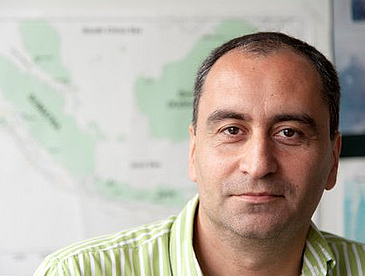Over the past 25,000 years the tropical forests of Indonesia have responded quite differently to extreme changes in climate and rainfall. Evidence of this is contained in a study made by an international team of researchers that included Dr. Mahyar Mohtadi Hamadani, a marine geologist from the University of Bremen. The study recently appeared in the science journal Nature Geoscience.
Working together with other researchers from the USA, Switzerland, Australia and Germany the Bremen scientist analyzed sediment cores taken from the Pacific and Indian oceans. The study findings: The evergreen rain forests seem to be able to cope with fluctuating levels of rainfall. However, the monsoon forests of the Indonesian archipelago are dependent on the rhythm of rainy and dry periods. During prolonged periods of very dry weather they are pushed back by savanna-like grasslands. The study gives rise to questions about how the tropical forests will respond to future climate change which will most likely strengthen seasonal climate fluctuation.
Rainforest vs. monsoon forest
On both sides of the equator there is a thousand-mile long warm water zone with average temperatures of over 28 degrees Celsius. The island state of Indonesia lies right in the middle of this. The warmed-up ocean releases large amounts of humidity into the atmosphere, causing between 2, 000 and 3,000 millimeters of rain to fall over the “maritime continent” per year. Small wonder, then, that evergreen tropical rainforests thrive there, for example on Borneo. Further south and south-west, though, on Sulawesi or the Moluccas, the monsoon determines Indonesia's vegetation, with periods of extreme precipitation followed by a dry season. Compared with the evergreen rainforest, trees in the tropical monsoon forest, including teak for example, are smaller. Moreover, they cast off their leaves during the dry season.
Sediment cores provide clues
The research team was investigating the previously widely unexplained question of how the vegetation of the two forest types is likely to respond to lasting changes in climate and rainfall. Sediment cores were at the center of their research. These shed light on the vegetation of tropical rainforests, on the one hand, and the development of monsoon forests, on the other. The team was particularly interested in the pollen and vegetable waxes found in the core samples, as these can provide evidence of what the vegetation was like in times long past.
Analysis revealed that the vegetation of the tropical rainforests has hardly changed at all since the peak of the last ice age. At that time the vegetation on Borneo was much the same as today, i.e. evergreen rainforest with its typical four layers of vegetation.
Drought stress in the tropical forest
"To our surprise, though, we found it is quite a different story for the monsoon forests in the southern part of the archipelago", says Dr. Mahyar Mohtadi, who co-authored the study in Nature Geoscience. "Our investigations show that the periods of drought following the monsoon at the height of the last ice age were not only much more severe but that they also lasted longer. In response to this drought stress we found that savanna-like grasslands encroached on the forest." Charcoal contained in the sediment cores shows the landscape dried out to such an extent that lightening was able to start wild fires. These may also have played their part in rolling back the forest vegetation. "The considerably lower sea level at that period may quite possibly be responsible", the Bremen marine geologist explains. "This caused part of the Indonesian continental shelf to dry out, among other things affecting the transport from the Pacific over the land."
Compared to today, 20,000 years ago the contrasts between dry and wet periods were much more pronounced. On the other hand, investigations indicate that the rhythm of the monsoon is changing as result of today's ongoing global change. "The question is", says Mahyar Mohtadi, "how things will develop and how the vegetation is likely to respond. We should remember that millions of people in the affected region live from agriculture – and with the constant change from rainy to dry seasons."
The study:
Nathalie Dubois et al.: Indonesian vegetation response to changes in rainfall seasonality over the past 25,000 years; in: Nature Geoscience (2014); doi: 10.1038/ngeo2182, Posted online on 1 June 2014.
http://www.nature.com/ngeo/journal/vaop/ncurrent/full/ngeo2182.html
For further information / requests for interviews / image material:
Albert Gerdes
MARUM-Öffentlichkeitsarbeit
Phone: +49 421 218-65540
e-mail: agerdesprotect me ?!marumprotect me ?!.de

